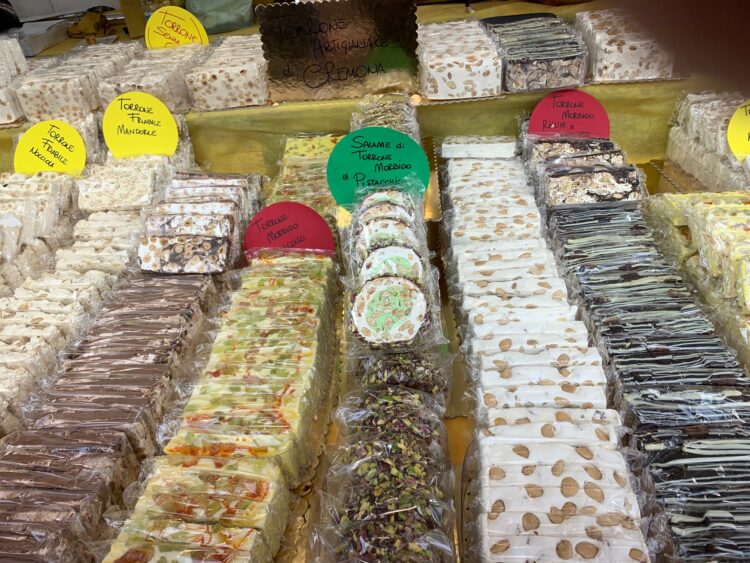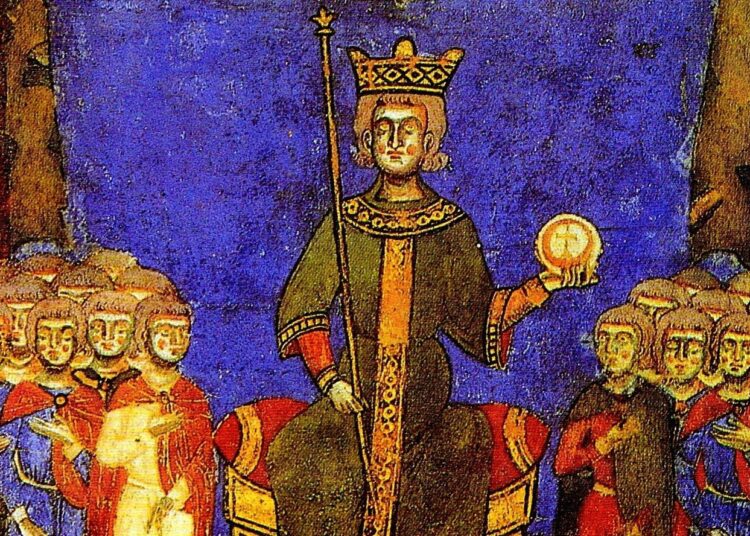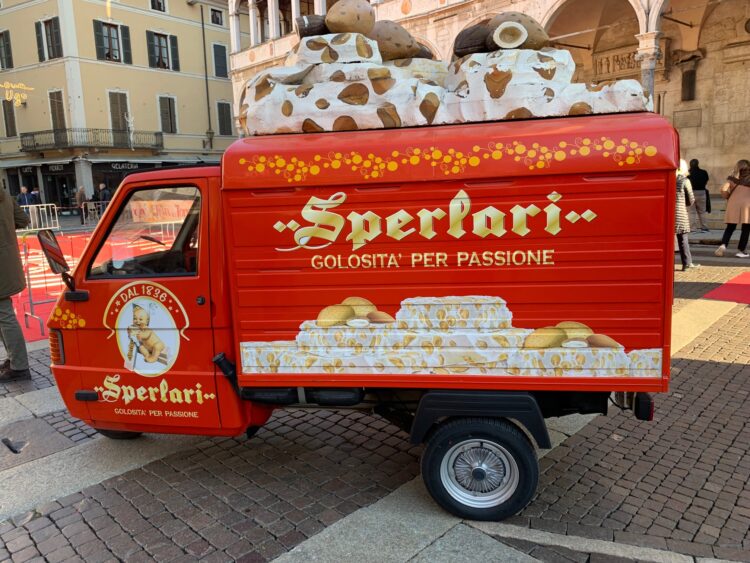When and where was torrone first created? No one knows for certain. Some connoisseurs say Persia; others Arabia; and still others China. A clue lies in its list of ingredients, which is short and sweet: almonds, honey, sugar and egg white, although other nuts (pistachios, walnuts and hazelnuts), candied fruits and chocolate can be added.

Thus, no matter where its birthplace, torrone almost certainly reached Europe from the Middle East, whether it was thanks to the Crusaders or more likely earlier, through Arab traders in Ancient Rome. All versions of its name turrón in Spanish, torró in Catalan, torrone in Brazilian and Brazilian Portuguese besides Italian, turrone in Sardinian, torrão in European Portuguese, and turon in Tagalog, appear to have been derived from Latin torrere (to toast). So the modern confection probably originates from a Muslim recipe, prevalent in parts of Islamic Spain and known as turun. It’s certainly popular at Christmastime in Spain, particularly in Alicante and in Toledo, as well as in countries formerly part of the Spanish Empire, particularly in Latin America, but in the Philippines too. However, a similar confection named cupedia or cuperto was marketed in ancient Rome and noted by ancient Roman poets.
Today Italian torrone is particularly popular all over Sicily–especially Condorelli’s brightly-wrapped torroncini; in Bagnara and Taurianova in Calabria; in Benevento near Naples, best at Fabbriche Riunite Torrone di Benevento; in Abruzzo best at Le Sorelle Nurzia in L’Aquila and at the Pasticceria Lullo in Guardiagrele where its recipe includes candied fruit and cinnamon; as well as in Sardinia, where it’s particularly cloyingly sweet and very chewy; and Cremona in Lombardy, birthplace of Stradivarius, so frequently made there in the shape of violins.

Every mid-November for the past 25 years, a festival in Cremona celebrates this delectable sweet. This year La Festa del Torrone took place from 12-20 November and counted over 400,000 visitors including me, a guest of Cremona Tourism. Next year’s dates are 13-21 November.
The first documents mentioning torrone in Cremona date to the reign of Holy Roman Emperor, super-cultured, multi-lingual, Frederick II (r. 1220-1250) when Cremona was already one of northern Italy’s most powerful cities. Frederick II, whose birthday was December 26 hence likely torrone’s Christmas connection, visited here 16 times with his entourage of Sicilian cooks well versed in Arab culture. However, their recipe did not include egg white, so it was crunchier. Instead, local lore claims that torrone’s debut was in 1441 as a tower-shaped dessert created for the marriage on October 25th in the Abbey of San Sigismondo, of Francesco Sforza (1401-66), one of 7 illegitimate sons of the condottiere Muzio Sforza, and the also illegitimate yet very intellectual Maria Bianca Visconti (1425-1468), a passionate hunter and lover of horses. The court’s Sicilian pastry chefs were inspired by the Torrazzo or the brick bell tower next door to the Cathedral. Built between 1230-1309, at some 112 m. tall, it’s one of the tallest still-integral bell towers of medieval Europe and today the symbol of Cremona. Every year on the Festa’s first Sunday afternoon, the wedding is reenacted with a procession of musicians, sbandieratori, and ladies-in-waiting who accompany Maria to the Cathedral where Francesco awaits her.

One of Italy’s most appreciated torroni is Cremona’s native-son Sperlari, founded by Enzo Sperlari in 1836 and official supplier to the Italian Royal Family. A major sponsor for the Festa, it still has its flagship atmospheric 19th-century store on Via Solferino 25, tel. 011-39-0372-22346), www.sperlari.it, for online orders: www.shop.sperlari1836.com.
Cremona’s homemade torroni can be ordered online from Enoteca Cremona, (Via Platina 18, 011-39-0372-451771), www.enotecacremona.it (click on specialità for its scrumptious torta torrone “Ad Libitum”), e-mail: moc.liamg@anomercacetone or from Pasticceria Fieschi, founded in 1867, Via Lanaoli 24,011-39-0372-32495, www.fieschi1867.com, e-mail: moc.7681ihcseif@ofni or chocolatier Tosca Cremona (Via Monteverdi 34, San Vito-26011 Castelbuttano ed Uniti (Cremona), 011-39-0374-374-361386)only www.toscacremona.it, e-mail: ti.anomercacsot@ofni.

The Italian varieties of torrone differ from the Spanish ones because they use a lower proportion of nuts in the confection. Traditional versions from Cremona range widely in texture (morbido, soft and chewy, to duro, hard and brittle) and in flavor (at the many white-tented stands in Cremona’s many piazzas I counted several: citrus fruits, limoncello, rum, black cherry, coffee, coco, raspberry and chocolate, coconut, blueberry, marron glacé, liquorice, and vanilla, added to the traditional nougat (English for torrone) and many contained whole hazelnuts, walnuts and pistachios as well as the traditional almonds. Some were also dipped in chocolate.
Torrone di Benevento goes by its historic name Cupedia, which signifies the crumbly version made with hazelnuts. The softer version is made only with almonds. The Torrone di Benevento, considered to be “The Boot”’s oldest, predates Roman times. Today it’s very popular in the territories of Samnium and differs only marginally from the varieties of Torrone di Cremona. Thanks to Frederick II?












